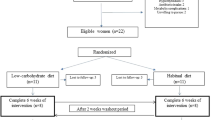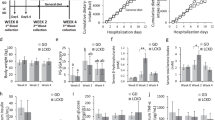Abstract
Although metabolomics studies are recently spreading and have allowed the characterization of putative biomarkers in many diseases, they are relatively scanty in anorexia nervosa (AN). In this explorative study we analyzed the fecal metabolomics profiles of women with AN in the underweight phase (n = 24) and after short-term weight restoration (n = 16) and compared them with 20 healthy women. An untargeted metabolomic procedure allowed the characterization of 224 metabolites involved in energy, lipid, and amino acid metabolism. A partial least square discriminant analysis identified 14 metabolites with a variable importance in projection score >1.5 that clearly differentiated underweight from weight-restored patients from healthy women. Compared with healthy women, fecal concentrations of valeric acid and 3-methyl,2-ketobutyric acid were increased in both underweight and weight-restored patients; fecal concentrations of propionic acid, stearic acid, linolenic acid, methyl-galactoside, coprosterol, cycloserine, and lauric acid were increased while fecal levels of xylose, fucose, and rhamnose were decreased in underweight patients and normalized after weight-restoration; fecal concentrations of piperine, phenylalanine, butyric acid, and meso-erythritol-1 were decreased while fecal levels of hydroxystearic acid were increased in weight-restored but normal in underweight AN patients. All these changes point to peculiar fecal metabolomics profiles of acute and short-term weight restored AN patients. The value of these changes to improve our understanding of the pathophysiology of AN and to characterize potential biomarker targets for developing new treatment strategies needs further studies to be clarified.
This is a preview of subscription content, access via your institution
Access options
Subscribe to this journal
Receive 12 print issues and online access
$259.00 per year
only $21.58 per issue
Buy this article
- Purchase on Springer Link
- Instant access to full article PDF
Prices may be subject to local taxes which are calculated during checkout




Similar content being viewed by others
References
Hoek HW, van Hoeken D. Review of the prevalence and incidence of eating disorders. Int J Eat Disord. 2003;34:383–96.
Kristal BS, Shurubor YI, Kaddurah-Daouk R, Matson WR. High performance liquid chromatography separations coupled with coulometric electrode array detectors: a unique approach to metabolomics. Methods Mol Biol. 2007;358:159–74.
Dunn WB, Broadhurst DI, Atherton HJ, Goodacre R, Griffin JL. Systems level studies of mammalian metabolomes: the roles of mass spectrometry and nuclear magnetic resonance spectroscopy. Chem Soc Rev. 2011;40:387–426.
Gowda GAN, Zhang S, Gu H, Asiago V, Shanaiah N, Raftery D. Metabolomics-based methods for early disease diagnostics. Expert Rev Mol Diagn. 2008;8:617–33.
Quinones MP, Kaddurah-Daouk R. Metabolomics tools for identifying biomarkers for neuropsychiatric diseases. Neurobiol Dis. 2009;35:165–76.
Holman RT, Adams CE, Nelson RA, Grater SJ, Jaskiewicz JA, Johnson SB, et al. Patients with anorexia nervosa demonstrate deficiencies of selected essential fatty acids, compensatory changes in non essential fatty acids and decreased fluidity of plasma lipids. J Nutr. 1995;125:901–7.
Moyano D, Vilaseca MA, Artuch R, Lambruschini N. Plasma amino acids in anorexia nervosa. Eur J Clin Nutr. 1998;52:684–9.
Kaye WH, Barbarich NC, Putnam K, Gendall KA, Fernstrom J, Fernstrom M, et al. Anxiolytic effects of acute tryptophan depletion in anorexia nervosa. Int J Eat Disord. 2003;33:257–67.
Zak A, Vecka M, Tvrzicka E, Hruby M, Novak F, Papezova H, et al. Composition of plasma fatty acids and non-cholesterol sterols in anorexia nervosa. Physiol Res. 2005;54:443–51.
Attia E, Wolk S, Cooper T, Glasofer D, Walsh BT. Plasma tryptophan during weight restoration in patients with anorexia nervosa. Biol Psychiatry. 2005;57:674–8.
Ehrlich S, Franke L, Schneider N, Salbach-Andrae H, Schott R, Craciun EM, et al. Aromatic amino acids in weight-recovered females with anorexia nervosa. Int J Eat Disord. 2009;42:166–72.
Focker M, Timmesfeld N, Scherag S, Knoll N, Singmann P, Wang-Sattler R, et al. Comparison of metabolic profiles of acutely ill and short-term weight recovered patients with anorexia nervosa reveals alterations of 33 out of 163 metabolites. J Psychiatr Res. 2012;46:1600–9.
Shih PB, Yang J, Morisseau C, German JB, Zeeland AA, Armando AM, et al. Dysregulation of soluble epoxide hydrolase and lipidomic profiles in anorexia nervosa. Mol Psychiatry. 2016;21:537–46.
Jansson J, Willing B, Lucio M, Fekete A, Dicksved J, Halfvarson J, et al. Metabolomics reveals metabolic biomarkers of Crohn’s disease. PLoS ONE. 2009;4:e6386.
Goedert JJ, Sampson JN, Moore SC, Xiao Q, Xiong X, Hayes RB, et al. Fecal metabolomics: assay performance and association with colorectal cancer. Carcinogenesis. 2014; 35:2089–96.
First MB, Williams JBW, Karg RS, Spitzer RL. User’s guide for the structured clinical interview for DSM‐5 disorders, research version (SCID‐5‐RV). Arlington, VA: American Psychiatric Association; 2015.
Dalle Grave R. Intensive cognitive behavior therapy for eating disorders. Hauppauge, NY: Nova; 2012.
Dalle Grave R, Calugi S, Conti M, Doll H, Fairburn CG. Inpatient cognitive behaviour therapy for anorexia nervosa: a randomized controlled trial. Psychother Psychosom. 2013;82:390–8.
Sheehan DV, Lecrubier Y, Sheehan KH, Amorim P, Janavs J, Weiller E, et al. The Mini-International Neuropsychiatric Interview (M.I.N.I.): the development and validation of a structured diagnostic psychiatric interview for DSM-IV and ICD-10. J Clin Psychiatry. 1998;59:22–33.
Fairburn CG, Cooper Z. (1993). The eating disorder examination. In: Fairburn CG, Wilson GT (eds). Binge Eating: Nature, Assessment, and Treatment (pp. 317–60). New York: Guilford Press.
Calugi S, Ricca V, Castellini G, Lo Sauro C, Ruocco A, Chignola E, et al. The eating disorder examination: reliability and validity of the Italian version. Eat Weight Disord. 2015;20:505–11.
De Leo D, Frisoni GB, Rozzini R, Trabucchi M. Italian community norms for the brief symptom inventory in the elderly. Br J Clin Psychol. 1993;32:209–13.
Derogatis LR, Spencer PM. The brief symptom inventory: administration, scoring and procedures manual. Baltimore: Clinical Psychometric Research; 1982.
Wold S, Sjöström M, Eriksson L. PLS-regression: a basic tool of chemometrics. PLS Methods. 2001;58:109–30.
Sysi-Aho M, Katajamaa M, Yetukuri L, Oresic M. Normalization method for metabolomics data using optimal selection of multiple internal standards. BMC Bioinform. 2007;8:93.
Mevik BH, Wehrens R. The pls package: principal component and partial least squares regression in R. J Stat Softw. 2007;1:1–23.
Kuhn M. Building predictive models in R using the caret package. J Stat Softw. 2008;1:1–26.
Szymańska E, Saccenti E, Smilde AK, Westerhuis JA. Double-check: validation of diagnostic statistics for PLS-DA models in metabolomics studies. Metabolomics. 2012;8:3–16.
Domingos P. MetaCost: a general method for making classifiers cost-sensitive. In: Proceedings of the fifth ACM SIGKDD international conference on Knowledge Discovery and Data mining. ACM Press: San Diego, CA, (1999).
Karnovsky A, Weymouth T, Hull T, Tarcea VG, Scardoni G, Laudanna C, et al. Metscape 2 bioinformatics tool for the analysis and visualization of metabolomics and gene expression data. Bioinformatics. 2012;28:373–80.
Nishida K, Ono K, Kanaya S, Takahashi K. KEGGscape: a Cytoscape app for pathway data integration. F1000 Res. 2014;3:144.
Guyon I, Weston J, Barnhill S, Vapnik V. Gene selection for cancer classification using support vector machines. Mach Learn. 2002;46:389–422.
Li T, Zhang C, Ogihara M. A comparative study of feature selection and multiclass classification methods for tissue classification based on gene expression. Bioinformatics. 2004;20:2429–37.
Wang L, Chu F, Xie W. Accurate cancer classification using expressions of very few genes. ACM Tran Comput Biol Bioinforma. 2007;4:40–53.
Li MX, Yeung JM, Cherny SS, Sham PC. Evaluating the effective numbers of independent tests and significant p-value thresholds in commercial genotyping arrays and public imputation reference datasets. Hum Genet. 2012;131:747–56.
Nyholt DR. A simple correction for multiple testing for single-nucleotide polymorphisms in linkage disequilibrium with each other. Am J Hum Genet. 2004;74:765–9.
Mitchell M. An introduction to genetic algorithms. MIT press: Cambridge, MA; 1998.
Troisi J, Landolfi A, Sarno L, Richards S, Symes S, Adair D, et al. A metabolomics-based approach for non-invasive screening of fetal central nervous system anomalies. Metabolomics. 2018;14:77.
Herpertz-Dahlmann B, Seitz J, Baines J. Food matters: how the microbiome and gut-brain interaction might impact the development and course of anorexia nervosa. Eur Child Adolesc Psychiatry. 2017;26:1031–41.
Morita C, Tsuji H, Hata T, Gondo M, Takakura S, Kawai K, et al. Gut dysbiosis in patients with anorexia nervosa. PLoS ONE. 2015;10:e0145274.
Borgo F, Riva A, Benetti A, Casiraghi MC, Bertelli S, Garbossa S, et al. Microbiota in anorexia nervosa: the triangle between bacterial species, metabolites and psychological tests. PLoS ONE. 2017;12:e0179739.
Louis P, Young P, Holtrop G, Flint HJ. Diversity of human colonic butyrate-producing bacteria revealed by analysis of the butyryl-CoA:acetate CoA-transferase gene. Environ Microbiol. 2010;12:304–14.
Scott KP, Martin JC, Campbell G, Mayer CD, Flint HJ. Whole-genome transcription profiling reveals genes up-regulated by growth on fucose in the human gut bacterium “Roseburia inulinivorans”. J Bacteriol. 2006;188:4340–9.
Harrison IF, Dexter DT. Epigenetic targeting of histone deacetylase: therapeutic potential in Parkinson’s disease? Pharm Ther. 2013;140:34–52.
Collins SM, Surette M, Bercik P. The interplay between the intestinal microbiota and the brain. Nat Rev Microbiol. 2012;10:735–42.
Tedelind S, Westberg F, Kjerrulf M, Vidal A. Anti-inflammatory properties of the short-chain fatty acids acetate and propionate: a study with relevance to inflammatory bowel disease. World J Gastroenterol. 2007;13:2826–32.
Ruijschop RMAJ, Boelrijk AEM, Giffela MC. Satiety effects of a dairy beverage fermented with propionic acid bacteria. Int Dairy J. 2008;18:945–50.
Gao Z, Yin J, Zhang J, Ward RE, Martin RJ, Lefevre M, et al. Butyrate improves insulin sensitivity and increases energy expenditure in mice. Diabetes. 2009;58:1509–17.
Schroeder FA, Lin CL, Crusio WE, Akbarian S. Antidepressant-like effects of the histone deacetylase inhibitor, sodium butyrate, in the mouse. Biol Psychiatry. 2007;62:55–64.
Davis M, Ressler K, Rothbaum BO. Effects of d-cycloserine on extinction: translation from preclinical to clinical work. Biol Psychiatry. 2006;60:369–75.
Siegmund A, Golfels F, Finck C. D-Cycloserine does not improve but might slightly speed up the outcome of in-vivo exposure therapy in patients with severe agoraphobia and panic disorder in a randomized double blind clinical trial. J Psychiatr Res. 2011;45:1042–7.
Levinson CA, Rodebaugh TL, Fewell L, Kass AE, Riley EN, Stark L, et al. D-Cycloserine facilitation of exposure therapy improves weight regain in patients with anorexia nervosa: a pilot randomized controlled trial. J Clin Psychiatry. 2015;76:787–93.
Allen KL, Mori TA, Beilin L, Byrne SM, Hickling S, et al. Dietary intake in population-based adolescents: support for a relationship between eating disorder symptoms, low fatty acid intake and depressive symptoms. J Hum Nutr Diet. 2013;26:459–69.
Satogami K, Tseng PT, Su KP, Takahashi S, Ukai S, Li DJ, et al. Relationship between polyunsaturated fatty acid and eating disorders: systematic review and meta-analysis. Prostaglandins Leukot Essent Fat Acids. 2019;142:11–19.
Shih PB, Morisseau C, Le T, Woodside B, German JB. Personalized polyunsaturated fatty acids as a potential adjunctive treatment for anorexia nervosa. Prostaglandins Other Lipid Mediat. 2017;133:11–19.4.
Shih PB, Yang J, Morisseau C, German JB, Zeeland AA, Armando AM, et al. Dysregulation of soluble epoxide hydrolase and lipidomic profiles in anorexia nervosa. Mol Psychiatry. 2016;21:537–46.
Nakai Y, Noma S, Fukusima M, Taniguchi A, Teramukai S. Serum lipid levels in patients with eating disorders. Intern Med. 2016;55:1853–7.
Author information
Authors and Affiliations
Corresponding author
Ethics declarations
Conflict of interest
The authors declare that they have no conflict of interest.
Additional information
Publisher’s note Springer Nature remains neutral with regard to jurisdictional claims in published maps and institutional affiliations.
Supplementary information
Rights and permissions
About this article
Cite this article
Monteleone, P., Monteleone, A.M., Troisi, J. et al. Metabolomics signatures of acutely ill and short-term weight recovered women with anorexia nervosa. Mol Psychiatry 26, 3980–3991 (2021). https://doi.org/10.1038/s41380-019-0573-3
Received:
Revised:
Accepted:
Published:
Issue Date:
DOI: https://doi.org/10.1038/s41380-019-0573-3



